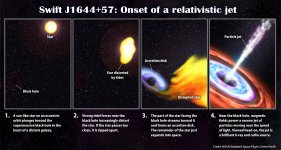Everybody happy?
Not particularly, as there are other threads in which to discuss music.

Had I known obfuscation is your preference, I would have.Disco-Pete, the Scientific method is to state your references! Otherwise we are guessing!
I have listened to the occasional John Fogerty album.
To my surprise, he wrote "Proud Mary". I would have swore Ike Turner did it.
But nobody did it like Tina:
BTW, and not many people know this. But when you hold up your right hand... Well that is Gospel.

however, my apologies. 😳
"to your surprise"? Oh my goodness you've led a (cloistered) sheltered life?
My general approach to Life is to let your opponent come on to you. Thus revealing his weaknesses! 😉
A short counter Punch is all that is required. I flow like Water. It's easy.
A short counter Punch is all that is required. I flow like Water. It's easy.
Back to Quasars. Seems most of the really big ones we are seeing are from the first 1-3 billion yrs of the universe's existence, although the closest one is 600m LY away - so a bit of an outlier.
One of the largest, 3C 273, is so powerful that if the solar system was placed 234 LY from its centre, it would be as bright as the mid day sun. These objects are trillions of times more powerful than the sun - of the order of 10^40 watts vs c. 3.8 x 10^26 watts from the sun.
A lot of these quasars are clustered into huge structures, so the prevailing thinking is they were formed when the universe was very young and there was plenty of matter to create the monstrous BH that are at the heart of quasars. It is likely that, as mentioned in the post by Galu, that by now they would have swept up most of the matter around them and are dormant - so we are seeing them as they were 10-13 billion years ago.
One of the largest, 3C 273, is so powerful that if the solar system was placed 234 LY from its centre, it would be as bright as the mid day sun. These objects are trillions of times more powerful than the sun - of the order of 10^40 watts vs c. 3.8 x 10^26 watts from the sun.
A lot of these quasars are clustered into huge structures, so the prevailing thinking is they were formed when the universe was very young and there was plenty of matter to create the monstrous BH that are at the heart of quasars. It is likely that, as mentioned in the post by Galu, that by now they would have swept up most of the matter around them and are dormant - so we are seeing them as they were 10-13 billion years ago.
One up tesla
OK. I love the Tesla connection, but hate the clickbait title. 😵
Back to Quasars.
Quasars are active galactic nuclei which are among the brightest objects, and therefore the most distant, we can see.
They are so bright, that they are visible at a distance of many billions of light years.
Because they are so far away, quasars serve as excellent fixed points in the sky, allowing a pair of radio telescopes (one in Europe and one in the USA) to triangulate the distance between Europe and the USA.
By this means we can determine that Europe is moving away from the USA at the rate of 2.3 cm per year, which is the speed at which fingernails grow.
Satellite laser ranging and GPS measurements give compatible results.
3C 273 ... the prevailing thinking is they (quasars) were formed when the universe was very young
Quasar 3C 273 lies at a redshift of 0.1583, but this is peanuts compared to the 11.1 redshift of galaxy GN-z11.
GN-z11 is so far away that it existed a mere 400 million years after the Big Bang, or about 13.3 billion years ago.
GN-z11 is not a quasar, but is bright enough to be visible to Hubble because it is forming stars at 20 times the current rate of the Milky Way.
This farthest galaxy is probably representative of the first generations of stars to form around black holes.
https://www.space.com/32150-farthes...,the Big Bang, 13.8 billion years ago (right).
Attachments
it wasn't a clickbait atleast for the regular viewers. But ok.OK. I love the Tesla connection, but hate the clickbait title. 😵
ALL numbersAs the Forum's premier Mathematician, I must explore Homer Simpson's idea of 3987 as being interesting!
Alas, no such conclusion appeals to me. 3996 is of some interest. Being 6 x 666.
NO. 3987 and 4365 are dull numbers. Unless I have missed something.
https://en.wikipedia.org/wiki/Interesting_number_paradox
At least it's not one of those "over unity" videos that try to be serious about it ... funny how new terminology shows up when the old ("perpetual motion") is discredited and panned enough - LENR is another.Oh pleeez, vishal! 🙄
LENR?
Low Energy Nuclear Reactions.
I had to look it up!
Not to be confused with LNER (London North Eastern Railway). 😛
Low Energy Nuclear Reactions.
I had to look it up!
Not to be confused with LNER (London North Eastern Railway). 😛
Nice article here on BH and some with jets
https://astronomyhttps://astronomy.com/magazine/news/2021/12/how-do-black-holes-swallow-stars
https://astronomyhttps://astronomy.com/magazine/news/2021/12/how-do-black-holes-swallow-stars
Sagittarius A* eventual jets points to us :-/
There is a possibility of a TDE (Tidal Disruption Event) at the heart of the Milky Way galaxy - see Bonsai's link below.
https://astronomy.com/magazine/news/2021/12/how-do-black-holes-swallow-stars
A TDE occurs when a star is catapulted by gravitational perturbations directly towards a supermassive black hole.
The doomed star gets violently ripped apart in a matter of just a few hours, producing a highly energetic and luminous flare.
A TDE is so bright it can resemble a supernova, but such events are rare. Astronomers estimate that a TDE occurs in a galaxy the size of the Milky Way no more than once every 100,000 years, whereas a supernova occurs within such a galaxy roughly once a century.
Bonsai's link refers to Swift J1644+57 which was an unusual TDE in that it was over 10,000 times more energetic than normal thanks to its relativistic jet.
Judging by the rarity of TDEs in general and ones like Swift J1644+57 in particular, I think the chances of us here on Earth being in danger are remote indeed.
Attachments
No way! Surely you haven't had a falling out with your best friend?? 😡LENR?
I had to look it up!
😛
- Status
- Not open for further replies.
- Home
- Member Areas
- The Lounge
- What is the Universe expanding into..




